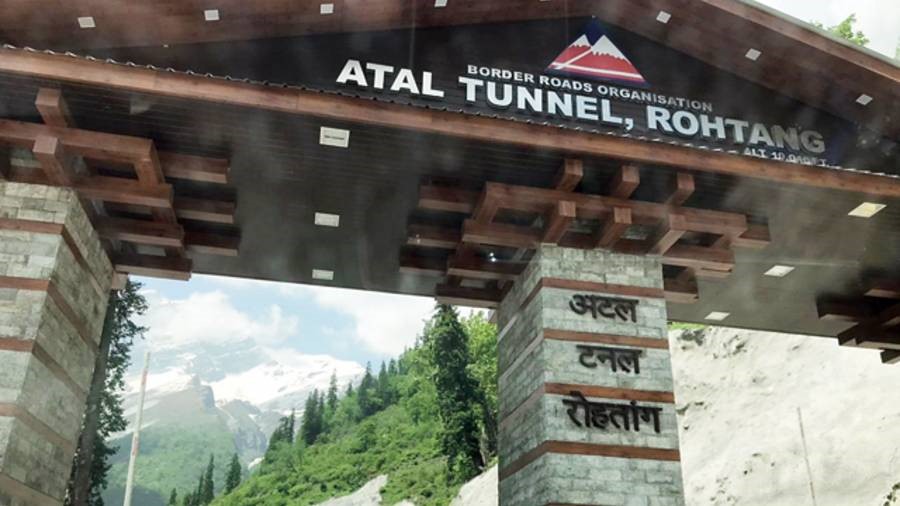Description

Disclaimer: Copyright infringement not intended.
Context
Traffic came to a halt at the Atal Tunnel in Rohtang near Manali following heavy snow.
Details
Atal Tunnel
- Atal Tunnel (also known as Rohtang Tunnel), named after former Prime Minister of India, Atal Bihari Vajpayee is a highway tunnel built under the Rohtang Pass in the eastern Pir Panjal range of the Himalayas on the National Highway 3 in Himachal Pradesh.
- At a length of 9.02 km, it is the highest highway single-tube tunnel above 10,000 feet (3,048 m) in the world.
- The tunnel is in the form of a single-tube double lane and has a shape similar to the horseshoe.
The project.
- It was inaugurated by Prime Minister Narendra Modi on 3 October 2020.
- The cost of the entire project is ₹3,200 crore (US$438 million
- The tunnel was completed by the Border Roads Organisation (BRO) under Ministry of Defence.
.jpg)
Significance:
- Reduced Road Distance: The distance between Manali and Leh is reduced by 46 KM by road which in turn reduced the time by 4 to 5 hours. As a result, the distance between Manali to Lahaul and Spiti Valley is estimated to be covered in about 15 minutes.
- Electromechanical Systems: The Tunnel has a system of separate ventilation ducts for fresh air, fire-fighting systems and solutions controlled by SCADA, fire hydrants at every 60 meters, turning cavern at every 2.2 km, and illumination. It also has two monitoring systems at both ends of the tunnel to analyze the movement of the vehicle and keep a view on pollution control.
- Connectivity Throughout the Year:The major advantage of the tunnel is in providing fascinating connectivity to Ladakh. Now the connection between Ladakh to Manali and Chandigarh exists throughout the year which was not possible before due to the winter season as the roads were covered with snow.
- Strategic Importance:The Tunnel was also treated as a boon for the armed forces. It gives continuous connectivity to the borders throughout the year. Due to snowbound reasons, earlier it was difficult for the armed forces to travel along the borders, but the foundation of this tunnel proved a boon for the armed forces with their easy access to the border areas.
- Availability of Essential Commodities:The necessities of life like petrol, vegetables, diesel, and other supplies would also be available throughout the year which was not possible earlier.
- Easy Access to Farmers, Horticulturalists, and Youth:The Tunnel also benefitted farmers and other daily living youth in India to have easy access to the capital of the country to approach job opportunities, sales, and consumer markets. In this way, farmers can protect their precious crops from decaying in the trucks before reaching the market.
- Motivate and Enhance Tourism:The Atal Tunnel will gradually enhance the tourism sector. This will improve the livelihoods of the people residing in Lahaul Valley and Ladakh and thus tourism.
- Network Connectivity:Three 4G base transceiver stations (BTS) were installed by BSNL in the Tunnel providing strong network connectivity which makes it possible for the residents to contact and reach the outside world. The Tunnel also possesses an automatic incident detection system along with high-resolution CCTV cameras at every 250 meters and a telephonic facility at every 150 meters.
- Emergency Terms and Conditions:The Atal Tunnel has a public announcement system in times of emergency. Avalanche control structures have also been constructed to prevent any damage to the roads.
New Austrian Tunnelling Method (NATM):
- The New Austrian Tunnelling Method (NATM) is a method of modern tunnel design and construction. This technique is quite popular, employing sophisticated monitoring to optimize various wall reinforcement techniques based on the type of rock encountered in tunnelling progresses. The method analyses the rock’s behaviour under load monitors the performance during underground construction and integrates both the principles during construction.
- Broad principles of NATM:
- Shot Crete Protection:Shotcrete is a mixture of aggregate and Portland cement, conveyed by compressed air to the nozzle of a spray gun. It involves the excessive rock mass deformation to be minimized by applying a layer of 25-50mm of sealing shotcrete immediately after the opening of the face. It is used to reinforce both temporary and permanent excavations.
- Mobilization of the Strength of Rock Mass:For the Tunnel to be strong, the mobilization of the strength of rockiness acts as an important factor. The primary support is analysed by checking whether the rock can support itself or not.
- Dynamic Design: The design is a dynamic factor during tunnel construction. The selection of the opening rock face and support is based upon the classification of different rocks. Simultaneously, the design is thereafter reinforced based on the deformation as everything is noticed during the monitoring.
- Other Features:Primary lining, the closing of inverts, measurements, and rock mass classification are the other principles of NATM.

AICTE’s Yuvak Scheme
- The All-India Council for Technical Education (AICTE) has recently introduced the Youth Undertaking Visit for Acquiring Knowledge (YUVAK) scheme with a vision to impart engineering prospects of the Atal Tunnel among students.
- The scheme was initiated to provide financial assistance to technical institutions under AICTE to conduct a study tour to Atal.
- The YUVAK program aims to exchange knowledge about the modern techniques and extraordinary efforts used in the construction of the tunnel. The purpose of the visit is also to impart knowledge of the New Austrian Tunnelling method to faculties and students.
- The YUVAK program will surely enhance the quality of engineering education in the colleges, inculcate research culture, promote innovation concept, project-based learning, and boost the confidence among the students to think differently.
|
PRACTICE QUESTION
Atal Tunnel, the world's longest highway tunnel connects Manali with ________.
- Kullu
- Shimla
- Jammu
- Lahaul-Spiti
Answer 4
|











